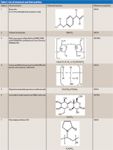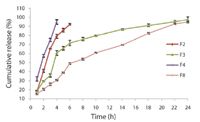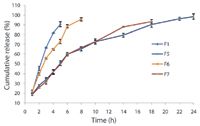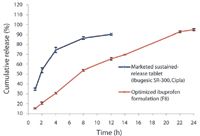Formulation and Evaluation of an Effervescent, Gastroretentive Drug-Delivery System
The authors developed a formulation for effervescent gastroretentive drug delivery techniques using ibuprofen as a model drug. They optimized the formulations by applying full factorial design.
Various sustained-release drug-delivery and drug-targeting systems are becoming increasingly important for minimizing drug degradation and loss, preventing harmful side effects, increasing drug bioavailability and delivering drug to the required site in the body. Among the various novel drug-delivery systems available, oral controlled-release systems are widely accepted because of their ease of administration, reduced dose and dosing frequency, stable drug levels, effectiveness in the treatment of chronic disease, and convenience for patients due to the systems' simplified dosing schedule (1).
Dosage forms that can be retained in the stomach are called gastroretentive drug-delivery systems (GRDDS). GRDDS are effective for localized drug delivery, lowering the incidence of gastric side effects, reducing irritation (because a small amount of drug is exposed to gastric mucosa at a specific time), and improving the controlled delivery of drugs that have an absorption window, thereby ensuring optimal bioavailability (2, 3).
This article focuses on a study involving a GRDD formulation using ibuprofen as a model drug. Ibuprofen is a prominent nonsteroidal anti-inflammatory drug used extensively to treat various musculoskeletal and joint disorders, mild to moderate pain, periarticular disorders, soft-tissue disorders, and fever. It also is used as an alternative to indomethacin to treat patent ductus arteriosus (4). The usual treatment amount for painful conditions is between 600 mg and 1.8 g daily in several doses. Patients with rheumatoid arthritis generally require higher doses of ibuprofen than those with osteoarthritis (5). The recommended dose for fever reduction in adults is 200–400 mg every four to six hours to a maximum of 1.2 g daily (4).
The drug has proven therapeutic efficacy, tolerability, and safety, and is, therefore, the drug of first choice in the management of these conditions (6). The drug's short plasma half-life (i.e., 2 h) necessitates frequent oral dosing to maintain the desired steady-state level, and this frequency can cause poor patient compliance (7). Furthermore, conventional dosage forms do not provide protection against early-morning joint stiffness, which is common in rheumatoid states (8). Thus, administering such a drug as a modified-release dosage form provides clinical benefit and related advantages. Because of the low amount of drug in the stomach, the controlled release of ibuprofen reduces risk of local irritation, compared with conventional dosage forms (9).
Materials
Ibuprofen was obtained as a sample from Alkem Laboratories (Mumbai). Hydroxypropyl methylcellulose (HPMC) K4M and K15M grades, carbomer 934P grade, and sodium bicarbonate were purchased from Central Drug House (Delhi, India). Polyvinyl pyrrolidone K30 grade, lactose, magnesium stearate, and purified talc were purchased from Loba Chemie (Mumbai). The purity and chemical structure of the chemicals are summarized in Table I. All other chemicals and reagents used in the study were of analytical grade. The authors conducted Fourier transform infrared spectroscopy studies to assess the ingredients' compatibility. Ibuprofen was incompatible with polyvinyl pyrrolidone, so Carbopol was used as binder. Magnesium stearate also was incompatible with ibuprofen at concentrations greater than 5%.

Table I: List of chemicals and their purities. (ALL IMAGES ARE COURTESY OF THE AUTHORS)
Methods
Formulation optimization. Experimental design can be defined as the strategy for setting up experiments in such a manner that the required information is obtained as efficiently and precisely as possible. The development of a new pharmaceutical formulation usually entails optimization. Factorial design is a system of experimental design by which the factors involved in a reaction or a process can be identified and their relative importance assessed. Factorial design has the following advantages (10, 11):
- It can be the design of choice for examining treatment variations because it has great flexibility for exploring or enhancing the signal (i.e., treatment) in studies.
- It is efficient because instead of conducting a series of independent studies, one can combine the studies into one.
- Factorial designs are the only effective way to examine interaction effects. They allow scientists to separate the important factors from the unimportant factors. In factorial designs, a factor is a major independent variable. A level is a subdivision of a factor.
Formulation trials. For the present study, 23 full factorial designs were selected. A polymer's viscosity grade is an important consideration in tablet formulation (12). When developing a controlled-release system that releases gas after contact with gastric fluid, a disintegrating agent also is important because it ensures that the swollen matrix disintegrates slowly (13, 14). So the ratios of HPMC K4M to HPMC K15M (2:1 and 1:1), the amounts of Carbopol (0 and 30 mg), and the amounts of sodium bicarbonate (90 and 144mg) were chosen as independent variables and studied at two levels of C1 (min) and C2 (max). Because the batches were optimized by 23 factorial designs, eight experiments were performed (see Table II). Total weight of the tablets was kept 700 mg by taking 310 mg (approx 45%) of drug mixed with excipients. Lactose was added to make up the total theoretical weight of the tablets. The ingredients were weighed accurately and mixed thoroughly. Effervescent controlled-matrix tablets were manufactured by direct compression of formulation ingredients with a sixteen-punch rotary tablet press (Pharmac, Pharmaceutical Machine Works, Indore, India). Magnesium stearate was used as a lubricant. Eight formulations were prepared and coded from F1 to F8. Each formulation's composition is summarized in Table III. Dissolution tests were performed using US Pharmacopeia Apparatus 2, at pH 1.2 to mimic the conditions that exist in the gastrointestinal tract (15).

Table II: 23 two-level, full factorial design (factors X1, X2, and X3).
Optimization of tablet batches on the basis of floating behavior. The randomly selected tablets from each formulation were kept in a 100-mL beaker containing simulated gastric fluid, pH 1.2 as per USP. The time taken for the tablet to rise to the surface and float was considered the floating lag time (FLT). The length of time that the dosage form remained on the surface of the medium was considered the total floating time (TFT) (16). Formulations F1, F2, F3, and F5 started to float after 5 min. Formulations F1, F2, F4, and F6 were dissolved within 3 h. Formulations F7 and F8 started to float within 1 min and swelled. Only formulation F8 maintained its integrity and floated for more than 24 h. Floating behavior is summarized in Table IV. Formulation F8 was selected as the optimized formulation because of its floating behavior.

Table III: Various batch formulations.
Physical evaluation of the optimized tablet formulation. The optimized tablet formulation's organoleptic properties were evaluated, and thickness and diameter were measured using vernier calipers (17). A weight-uniformity test was conducted on 20 of the prepared floating tablets. Tablet hardness was evaluated with a Monsanto tester (THT, Industrial Pharma, Delhi, India). The authors used a Roche type friabilator (EF-2, Electrolab, Delhi, India) to gauge the friability of 10 tablets (17, 18). All evaluated test data of the optimized tablet formulation were within pharmacopeial limits.

Table IV: Floating behavior of various formulations.
Determination of density. Density was determined using the liquid-displacement method (19, 20). Benzene, in which the tablet was insoluble, was used as intrusion in the glass pycnometer. Density of the optimized formulation was 0.978 g/cm–1.

Table V: Medium uptake by the optimized formulation.
Swelling characterization. The swelling properties of the formulation can be determined through various techniques (21). The medium uptake was evaluated using simulated gastric fluid as a medium for 2 h (see Table V). The dimensional changes are summarized in Table VI.

Table VI: Swelling characteristics (i.e., dimensional changes).
In vitro dissolution study. The cumulative drug release from each formulation was assessed using 900 mL of dissolution media (0.1 N HCl) in Apparatus 2 of USP XXI (15), with a paddle-rotation speed of 50 rpm. Aliquots of 10 mL were withdrawn after every hour. These aliquots were filtered through a 0.45-μm membrane filter and analyzed by measuring the absorbance, using the 0.1 N HCl as reference solution, at 221 nm (15). The absorbance values were transformed to concentration by reference to a standard calibration curve obtained experimentally (r2 = 0.999).

Figure 1: Release profiles of the formulations F2, F3, F4, and F8. See Table III for the batch formulations’ compositions.
The dissolution test was performed in triplicate for each batch, and t80 was calculated. The release rates of various formulations are shown in Figures 1 and 2, and release rates and t80 are summarized in Tables VII and VIII, respectively. The responses studied included the time needed for 50% of the drug to dissolve (T50), the diffusional exponent (n) that characterized the release mechanism, and the percent friability of the tablets. Analysis of variance indicated that the release rate (T50) was affected by the ratio of HPMC grades, the amount of Carbopol and sodium bicarbonate, and two-way and three-way interactions. The ratio of HPMC grades, the amount of Carbopol and sodium bicarbonate, the interactions between HPMC and Carbopol and HPMC and sodium bicarbonate, and also three-way interactions significantly affected the diffusional exponent (n). Tablet friability was affected significantly by all three factors.

Figure 2: Release profiles of the formulations F1, F5, F6, and F7. See Table III for the batch formulations’ compositions.
The formulation with the best release characteristics was F8. Sustained release of the optimized formulation was achieved over a period of 24 h. An average of 95–99% of the drug was released during this period. All the factors of formulation except F7 were insignificant (P > 0.05). From these results, it can be inferred that because all quadratic terms of the main factors and interactions were of little significance, a reasonably linear relationship linked both factors and the response, though interaction between main effects was significant.

Table VII: Dissolution studies of various batch formulations.
Drug-content estimation. For the drug-content estimation, 20 tablets of each formulation were added to 100 mL of 0.1 N HCl after triturating the tablets, followed by stirring for 30 min. The solution was filtered through a 0.45-μm membrane filter and diluted, and the absorbance of the resulting solution was measured spectrophotometrically at 221 nm using 0.1 N HCl as a blank. The drug content was uniform in all formulations.

Table VIII: t80 value of various formulations.
In vitro drug-release kinetic studies. The kinetic model described drug dissolution from the solid dosage form, where the dissolved amount of drug was a function of test time. To study the exact mechanism of drug release from the tablets, drug-release data were analyzed according to zero order, first order, Higuchi square root, and the Korsmeyer–Peppas model (22–25). The criteria for selecting the most appropriate model were chosen on the basis of the goodness-of-fit test.
Data analysis for drug-release kinetic. After applying the different release model to the dissolution release profile of the optimized formulation, the value of correlation-coefficient obtained by zero order, first order, Higuchi release, and Korsmeyer–Peppas model were 0.909, 0.774, 0.990, and 0.64, respectively. The optimized formulation thus follows the Higuchi release.

Table IX: Dissolution studies of marketed sustained-release formulations versus optimized ibuprofen formulation.
Dissolution studies of a marketed sustained-release formulation and the optimized ibuprofen formulation. Dissolution studies were also performed for a marketed sustained-release formulation (Ibugesic SR-300, Cipla, Mumbai) by using the same dissolution conditions. The comparative release data of both formulations are represented in Table IX and in Figure 3. The release data clearly demonstrate that the marketed sustained-release tablet releases 90.12% of drug in 12 h, while the optimized tablet releases 94.7% of drug in 24 h.

Figure 3: Dissolution studies of a marketed sustained-release formulation and an optimized ibuprofen formulation.
Conclusion
All three formulation variables evaluated in this study affected the release profiles and maintained the floating of the formulations. However, only the sodium-bicarbonate loading level was important within the selected range for floating properties because HPMC alone could not maintain the floating for more than 1 h. HPMC provided the sustained release, but the ratio of the grades was not important. Carbopol provided the binding capacity to the tablet and maintained the integrity of the tablet. When ibuprofen is administered as a conventional dosage form, it displays a short half life (i.e., 2 to 4 hours). By applying the direct tablet-compression method optimized by 23 full factorial design, the authors successfully developed a controlled-release intragastric floating system for ibuprofen that floated and provided sustained release for as long as 24 h. The statistical approach to formulation optimization was a useful tool, particularly when several variables needed to be evaluated.
A. Nanda is professor of pharmaceutics and dean at the Faculty of Pharmaceutical Sciences, M.D. University, Rohatak, Haryana, M. Ola* is a lecturer at the Goenka College of Pharmacy, Lachhmangarh, Sikar, India, R. Bhaskar is a lecturer at Seth G.L. Bihani S.D. College of Technical Education, Sriganganagar, India, and C.K. Sharma and S. Nayak are lecturers, both at the Goenka College of Pharmacy, tel. +91 97992 99708, monika.ola@rediffmail.com
*To whom all correspondence should be addressed.
Submitted: Aug. 14, 2009. Accepted: Feb. 18, 2010.
References
1. L.F. Prescott and W.S. Nimmo, Novel Drug Delivery and Its Therapeutic Application, F.L. Prescott, Ed. (John Wiley and Sons, Oxford, UK, 1989), pp. 1–11.
2. Y.W. Chien, "Controlled and Modulated-Release Drug Delivery Systems," in Encyclopedia of Pharmaceutical Technology, J. Swarbrick and J.C. Boylan, Eds. (Marcel Dekker, New York, 1990), p. 280.
3. G. Chawla et al., Pharm. Technol. 27 (7), 50–68 (2003).
4. Medicines Complete, "Ibuprofen/Indomethacin," www.medicinescomplete.com/mc/martindale/current, accessed Dec. 19, 2006.
5. J.C. Valle-Jones, J. Smith, and D. Rowely-Jones, Br. J. Clin. Pract. 38 (7), 353–358 (1984).
6. T.H. Kantor, Ann. Intern. Med. 91 (6), 877–882 (1979).
7. A. Avgerinos and S. Malamataris, Int. J. Pharm. 63 (1), 77–80 (1990).
8. N. Sarkar et al., Curr. Ther. Res. Clin. Exp. 44 (6), 11–21 (1988).
9. M. Galeon et al., Curr. Ther. Res. Clin. Exp. 29 (4), 217–234 (1981).
10. S. Bolton and Charles Bon, "Factorial Designs," in Pharmaceutical Statistics: Practical and Clinical Applications, J. Swarbrick, Ed. (Marcel Dekker, New York, 3rd ed., 1984), pp. 265–285.
11. N.A. Armstrong and K.C. James, "Factorial Designs of Experiments," in Understanding Experimental Design and Interpretation in Pharmaceutics, (Ellis Harwood, London, 1990), pp. 27–54.
12. R. Ziyaur, A. Mushir, and R.K. Khar, Acta Pharm. 56 (2), 49–57 (2006).
13. N. Tomoya et al., Chem. Pharm. Bull. 54 (6), 14–51 (2006).
14. B.S. Dave, A.F. Amin, and M.M. Patel, AAPS PharmSciTech 5 (2), 45–49 (2004).
15. USP 27–NF 22 (USP, Rockville, MD, 2003), pp. 953–955.
16. M. Rosa, H. Zia, and T. Rhodes, Int. J. Pharm. 105 (34), 65–70 (1994).
17. G.S. Banker and N.R. Anderson, "Tablets," in The Theory and Practice of Industrial Pharmacy, L. Lachmann, H.A. Liberman, and J.L. Kaing, Eds. (Varghese Publishing House, Mumbai, 3rd ed., 1987), pp. 295–299.
18. "Tablets" (Indian Pharmacopoeia, (Controller of Publication, Delhi, India, Vol. II, 1996), pp. 734–736.
19. J. Castellanos, M.R.H. Zia, and C.T. Rhodes, Int. J. Pharm. 105 (34), (Apr25), 65–70 (1994).
20. J.E. Devereux, J.M. Newton, and M.B. Short, J. Pharm. Pharmacol. 42 (8), 500–501 (1990).
21. V.S. Chitnis, V.S. Malshe, and J.K. Lalla, Drug Dev. Ind. Pharm. 17 (10), 879–892 (1991).
22. G.M. Khan, Sciences 1 (8), 350–354 (2001).
23. D.M. Morkhade, Indian J. Pharm. Sci. 68 (3), 53–58 (2006).
24. T. Higuchi, J. Pharm. Sci. 52 (12), 1145–1149 (1963).
25. N.A. Peppas and J.J. Sahlin, Int. J. Pharm. 57 (1), 169–172 (1989).

Drug Solutions Podcast: A Closer Look at mRNA in Oncology and Vaccines
April 30th 2024In this episode fo the Drug Solutions Podcast, etherna’s vice-president of Technology and Innovation, Stefaan De Koker, discusses the merits and challenges of using mRNA as the foundation for therapeutics in oncology as well as for vaccines.
Pharmaceutical Tariffs Are Imminent: How Industry is Bracing for Impact
April 16th 2025On April 14, 2025, the Trump Administration launched a national security-driven investigation into pharmaceuticals, a move that will likely result in tariffs being placed on pharmaceutical drugs, ingredients, and other components that are imported from outside of the United States.